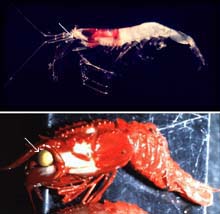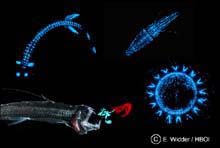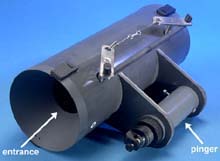
Note the difference in the eye size (white arrows) of the pelagic species Systellaspis (above) that lives between 500-700 m depth, and Glyphocrangon (below) that lives between 700-1500 m depth. Click image for larger view.
Visual Ecology and Bioluminescence
Tamara Frank
Biological Oceanographer, Harbor Branch Oceanographic Institution
Edith A. Widder
Senior Scientist, Harbor Branch Oceanographic Institution
Many deep-sea benthic animals have very large eyes, but the sensitivity level of these eyes, as well as what they are used for, has remained a mystery. The issue is confounded further by the fact that the eyes of pelagic animals—creatures that live in the water column—decrease in size after a certain depth, as sunlight penetration dims. Why then, do benthic species have large eyes at depths where pelagic species have small eyes?
The answer likely lies in the phenomenon known as bioluminescence—light generated by plants or animals. One familiar source of bioluminescence is the common firefly. However, bioluminescence is much more common in the ocean than on land. In fact, an estimated 90 percent of the animals that live below 500 m in the ocean’s pelagic zone are bioluminescent. Common bioluminescent animals in the pelagic zone include fish, squid, shrimp and jellyfish.
Scientists hypothesize that the huge eyes of deep-sea benthic creatures are adapted for viewing bioluminescence. But little is known about bioluminescence on the deep-sea floor, and we know virtually nothing about the visual systems of these deep-sea inhabitants.

A common source of bioluminescence in the pelagic zone include fish, squid, shrimp and jellyfish. Click image for larger view.
Detecting Bioluminescence
To explore for new sources of bioluminescence in the benthic environment, we will use an underwater intensified silicon intensified target (ISIT) video camera mounted on the deep-sea submersible Johnson-Sea-Link (JSL). We also will be using an ultraviolet light to detect fluorescence, which can be, but is not always, an indicator of bioluminescence. If we discover any new sources of bioluminescence, we will collect them for shipboard studies, such as measurement of the color of the light, known as the emission spectra.
Additionally, we will be using a new camera system developed for ocean exploration called Eye-in-the-Sea. This deep-sea observation tool can be left on the sea bottom to record animal behaviors after the noisy, brightly-lit submersible leaves the vicinity. The system uses an especially sensitive camera that can record bioluminescence. The camera is activated by a light sensor that detects bioluminescent flashes. After the camera comes on and records some of the bioluminescence, a red light turns on, revealing the animal. Based on Dr. Frank’s recordings from the eyes of deep-sea animals, we believe this light should be invisible to the animals. We hope that Eye-in-the-Sea will reveal behaviors and possibly even animals that no one has ever seen before.
Collecting Benthic Animals
Until recently, we have been unable to study the visual systems of these deep-sea species. Because their eyes are so sensitive to light, exposure to surface lights, even lights at night, permanently blinds them. Thus, standard commercial traps and trawls cannot be used to collect these animals. Instead, we will rely on special benthic traps designed by engineers at Harbor Branch Oceanographic Institute (HBOI) to collect specimens.
These traps are constructed from polyvinyl chloride (PVC) and are designed with funnels at the entrances. The funnels prevent a shrimp or small crab from escaping once it has entered the trap. Once the trap has been open for eight to 24 hours, the doors will close, leaving a trap that is light-tight and water-tight. A pinger attached to each trap emits a signal that allows the JSL to find and retrieve the trap. Because the traps are now closed, they can be picked up by the JSL without exposing the animals inside to the submersible’s bright lights.
The animals inside also will be immersed in cold water (4 degrees C) throughout their ride back to the surface, which will prevent any rapid pressure and water temperature changes that often kill most deep-sea animals brought to the surface. Deep-sea shrimp, if they are kept in the cold, dark water to which their bodies are adapted, can survive for weeks on the surface.
Once the animals are brought to the surface, the traps will be carried to an environmentally controlled room kept at 4 degrees C, where they will be opened under dim red light. The captured specimens will be placed in light-tight, water-filled tanks until we are ready to work on them.

These specially designed traps isolate the shrimps and crabs inside from light and elevated water temperatures as they are brought to the surface. Click image for larger view.
Sign up for the Ocean Explorer E-mail Update List.

































